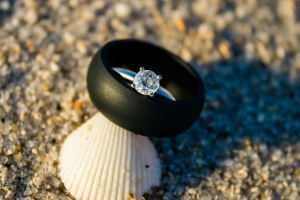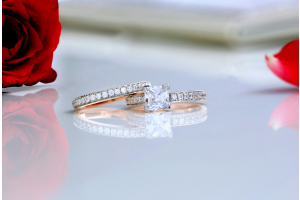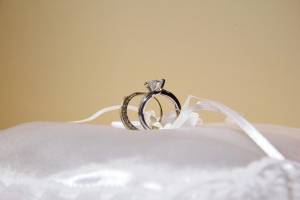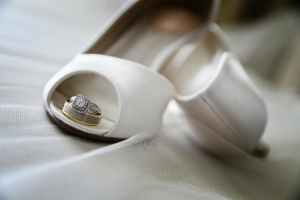GBP
/
GBP
/
Shipping to:
Currency:
How to Buy Engagement Rings That Last a Lifetime: A Complete Guide
An engagement ring is more than just a piece of jewellery; it symbolises a lifelong commitment and shared future. When choosing one, it’s important to ensure that the ring is not only beautiful but built to last. After all, it’s meant to be worn every day for years to come. This guide will walk you through the key factors to consider when selecting an engagement ring that will stand the test of time.
Understanding the Elements of a Long-Lasting Engagement Ring
Choosing an engagement ring that lasts goes beyond style; it’s about the quality of the materials, the craftsmanship, and a timeless design. Several aspects contribute to a ring's durability, including the type of metal, the setting, and the gemstone itself. Paying attention to these details ensures that your ring remains as stunning as the day you first slipped it on.
If you’re interested in understanding the different types of diamonds, check out our diamond search options to find high-quality stones that meet your requirements.
Selecting the Right Metal for Durability
The metal used for your engagement ring’s band is one of the most important decisions when aiming for longevity. Different metals offer varying levels of durability, so it’s crucial to choose one that can endure daily wear.
- Platinum: Renowned for its strength and resistance to scratching, platinum is an ideal choice for a lasting engagement ring. Its natural white sheen won’t fade over time, and it’s also hypoallergenic, making it suitable for sensitive skin. Although platinum is more expensive than other metals, its durability often justifies the investment.
- White Gold vs. Yellow Gold: While both types of gold are popular, there are key differences in terms of maintenance. White gold is often plated with rhodium to give it a brilliant shine, but this coating can wear away, requiring periodic replating. Yellow gold, on the other hand, is more resistant to fading but can be softer than white gold. Opting for 18-carat gold can offer a balance between durability and richness of colour.
- Rose Gold: This charming pinkish metal is an increasingly popular option for engagement rings. Although it’s not as hard-wearing as platinum, its durability can be enhanced by combining it with tougher alloys. However, rose gold tends to develop a patina over time, giving it a vintage look.
- Palladium: If you’re looking for something different, palladium offers a similar appearance to platinum but is lighter and often less costly. It’s also highly durable and requires minimal maintenance, making it a practical alternative.
Whichever metal you choose, maintaining its condition involves proper care. Regular cleaning and professional inspections can keep it looking new for decades.
Choosing a Diamond or Gemstone That Will Stand the Test of Time
When it comes to gemstones, diamonds are famed for their hardness and durability. However, not all diamonds are created equal, and some considerations can help ensure you select a gem that will last.
- Understanding the 4Cs: The four factors—cut, colour, clarity, and carat—determine a diamond’s overall quality and resilience. The cut affects how well the diamond reflects light, while clarity refers to the presence of imperfections. Colour impacts a diamond’s appearance, and carat denotes its size. For a durable diamond, pay particular attention to the cut, as a well-cut diamond is less likely to chip.
For those considering lab-grown options, explore our lab-grown diamonds, which offer exceptional quality and value while maintaining the same durability as natural diamonds.
- Alternative Gemstones: While diamonds are the hardest known natural material, other gemstones can also make beautiful, long-lasting engagement rings. Sapphires and rubies, for example, are nearly as durable as diamonds and come in a variety of stunning colours. However, softer gemstones such as opals or emeralds may be more prone to scratching and require extra care.
- Protecting Your Stone: Choosing a gemstone is not only about aesthetics but also about ensuring it’s well-protected. Certain settings can help shield the stone from accidental damage, making it a vital consideration. For those who want something unique, our collection of fancy coloured diamonds includes a variety of hues that offer both beauty and longevity.
The Importance of Ring Settings for Longevity
The setting plays a critical role in the durability of your engagement ring, as it holds the gemstone in place and offers protection against knocks and scratches.
- Types of Ring Settings: The most common settings include prong, bezel, channel, and tension settings. Prong settings are classic and popular, yet they expose more of the gemstone, making it slightly more vulnerable. Bezel settings, where the metal wraps around the stone, offer greater protection. Channel settings, often used for rings with multiple stones, secure the gems tightly in a row. Tension settings use the band’s pressure to hold the stone, giving a modern look but may not be as secure.
- Best Settings for Active Lifestyles: If you lead a particularly active lifestyle, opt for a setting that offers maximum protection, such as a bezel or half-bezel setting. This style can help shield the edges of the gemstone from impact.
- How to Choose a Secure Setting: When selecting a setting, ensure that it holds the gemstone firmly in place. The claws or bezel should fit snugly around the stone without appearing loose or uneven.
Craftsmanship: Why Quality Matters
A well-crafted ring isn’t just about aesthetics; it’s also about longevity. A high level of craftsmanship can significantly enhance a ring's ability to withstand wear and tear. When choosing an engagement ring, seek out jewellers with a reputation for quality. Handcrafted rings tend to have superior attention to detail compared to mass-produced options. Look for signs of quality craftsmanship, such as smooth edges, securely set stones, and a balanced design.
Ensuring Proper Ring Sizing
Getting the right ring size is crucial for both comfort and durability. A ring that fits too tightly may become misshapen over time, while one that's too loose risks slipping off. Aim for a fit that's snug enough to stay in place but can still slide over the knuckle without resistance. If you anticipate significant weight fluctuations in the future, consider choosing a setting that allows for resizing.
Regular Maintenance and Care Tips
To keep your engagement ring in top condition, routine maintenance is essential. Regular cleaning helps to remove dirt and oils that can dull the stone's brilliance, while periodic inspections can detect any signs of wear before they become problematic.
- Cleaning Your Engagement Ring: Different metals and gemstones require specific cleaning methods. For most rings, a gentle clean with warm water, a soft toothbrush, and a mild soap can restore its shine. Avoid harsh chemicals, especially for softer gemstones or plated metals.
- Routine Inspections: Having your ring professionally inspected every six months can help detect potential issues, such as loose prongs or damaged stones. Early intervention can prevent more extensive (and expensive) repairs.
- Common Repairs: Over time, rings may need minor repairs, such as prong tightening or refinishing. These repairs are typically quick and inexpensive but can extend the ring’s lifespan significantly.
- Home Care vs. Professional Care: While it’s beneficial to clean your ring at home, occasional professional cleaning ensures that the setting and stones are thoroughly cared for. Jewellers often use ultrasonic cleaners that can remove built-up grime more effectively than home methods.
Insurance: Protecting Your Investment
An engagement ring is not only a financial investment but an emotional one too. Insuring your ring offers peace of mind by covering loss, theft, or damage. When choosing insurance, look for a policy that provides coverage for the full replacement value and allows you to choose your jeweller for repairs.
Considering Future Upgrades and Changes
Even if your engagement ring is perfect as it is, there may come a time when you wish to upgrade or modify it. Perhaps you’d like to add extra diamonds or switch to a different setting. Choosing a style that can accommodate future changes makes this process simpler. Rings with a solitaire setting or multiple smaller stones offer flexibility for adding or altering gemstones.
Choosing a Timeless Design That Will Never Go Out of Style
While trends come and go, some designs remain perennially stylish. Opting for a timeless style means that your ring will always look elegant, regardless of changing fashions.
- Classic Engagement Ring Styles: Solitaire rings, three-stone settings, and halo designs have a timeless appeal that endures. These styles are elegant and versatile, making them ideal for those who prefer a traditional look. Explore our selection of round lab-grown diamonds for a classic choice or consider unique shapes like cushion cut diamonds or pear-shaped diamonds for something a bit different.
- Balancing Personal Style with Timelessness: You don’t have to sacrifice personal taste to achieve a lasting look. Consider choosing a classic design with unique touches, such as an engraving or an unusual gemstone cut.
For those looking for truly unique options, our collection of fancy coloured lab-grown diamonds offers various choices to suit any style.
FAQs
- How can I tell if an engagement ring is of high quality?
- High-quality engagement rings often feature well-crafted settings, securely placed gemstones, and smooth finishes. Look for reputable jewellers with a history of good craftsmanship.
- What is the best metal for a durable engagement ring?
- Platinum is the most durable metal due to its hardness and scratch resistance, though 18-carat gold also offers a good balance of durability and beauty.
- Are alternative gemstones as durable as diamonds?
- While diamonds are the hardest gemstone, sapphires and rubies are also highly durable and suitable for everyday wear. Softer stones like opals require more careful handling.
- How often should I get my engagement ring professionally cleaned?
- Aim for professional cleaning and inspection every six months to keep your ring looking its best and to catch any potential issues early.
- Is it worth insuring an engagement ring?
- Yes, insuring your engagement ring provides financial protection against theft, loss, and accidental damage. It offers peace of mind and ensures you’re covered in case of an unexpected event.







